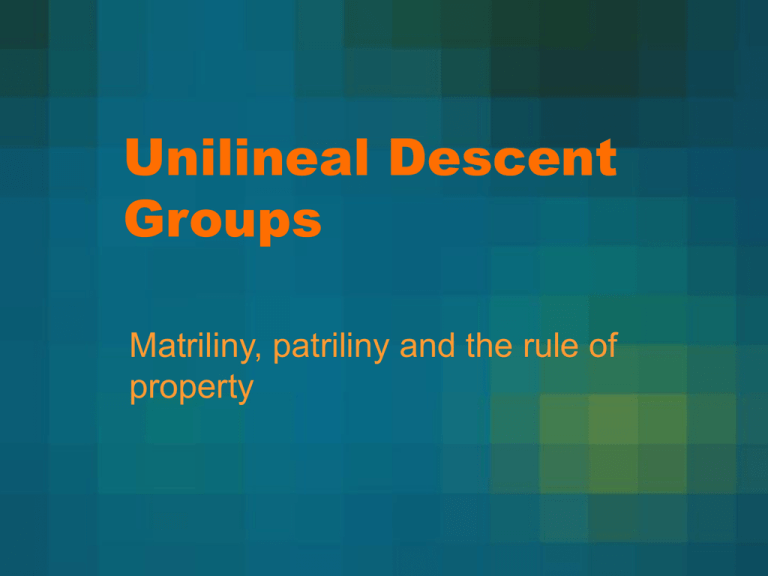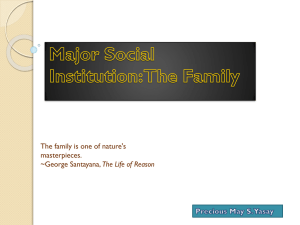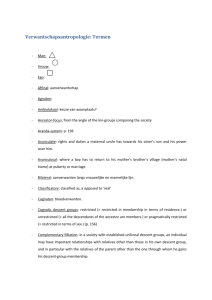Unilineal Descent Groups Matriliny, patriliny and the rule of property
advertisement

Unilineal Descent Groups Matriliny, patriliny and the rule of property Combinations of descent rules • Lineages and clans: lineages are defined as kin groupings in which direct descent is known, often goes back to a great-great grandparent. • Clans consist of several lineages, and are defined as groups which believe they share a common ancestor, but whose ancestor may be so far in the past that descent cannot be traced. • Clans and lineages can also combine in different ways: – Several clans can join together to become phratries. – More commonly, various clans are divided into two known sections, called moieties. Moieties and their permutations • Moieties are also referred to as dual organizations and are widespread throughout the world. • Not only do they order kinship, but also provide a conceptual classification of the environment and the spiritual world. – Winnegabo: ‘those above’ and ‘those on earth’, the former comprising clans named after birds, the latter called after land and water animals. The moieties formerly each occupied a definite half of the village and were pitted against each other in lacrosse. – Tlingit: a man never gives property to one of his own half-tribe, nor employs him for any services. A Raven always gets a Wolf to put up a house for him, to pierce his children’s ears, to initatie the youngsters into secret societies and vice versa. Feasts are given exclusively for the other half. – They are usually exogamous: this applies particularly if crosscousin marriage is the rule. In fact, the exogamous marriage rule can produce cross-cousin marriage patterns. Unilineal Descent and the status of the sexes • • Formerly, evolutionary theorists (Bachofen) postulated that matriarchies dominated in an early stage of human history. Lowie: cannot associate matriarchies with matrilineal descent. – – No society is purely matriarchal or purely patriarchal. E.g. the Iroquois: descent is matrilineal and women have the right to nominate and impeach chiefs. Can also withhold food if they wish to terminate a war. • • However, men always hold political office and have the right to declare war. Societies that we consider strongly patrilineal also often accord special privileges to women. – – E.g. Women in the middle east, where descent is patrilineal and residence patrilocal, also control the purse strings of the household, have control over their dowry, and husbands are required to part with 1/3 of their income to their wives. Another example: Igbo society of Nigeria: dual sex-gender system. Nominally patrilineal, there are special political and economic offices held only by women. Those women who accumulate wealth can also become ‘social husbands.’ Intensive agriculture, the rule of property and transformations in kinship • • • • • Historically, patrineality has become more frequent than matrilineality. Today, 65% of the world’s peoples are patrilineal, 30% are matrilineal and 5% are bilateral. Patrilineality is found much more frequently among peoples that are involved in intensive agriculture, i.e. that associated with the use of ploughs, draught animals and irrigation. These new technologies produced much greater surpluses than previously imagined. More concern with the control of wealth and of the importance of inheritance to maintain a family’s status over generations. Men also dominated production in plough agriculture and personal, private property in land became increasingly important. – Also increasing separation of public and private spheres. – Men wished to pass inheritance to sons. – Dowry became a form of inheritance for daughters, and dowry, i.e. the payment through a bride to the husband’s family, became more predominant. Conical clan, kinship, and the emergence of an aristocracy: What happens to kinship when wealth and property differences become Important? Mini-lineage h is less directly descended from the founding ancestor, being descended from the younger son of the younger son. Mini-lineage ‘a’ is the direct descendant of the eldest sons of the founding ancestor aristocracy commoners Radcliffe-Brown: A different sort of functionalist • • • • Radcliffe-Brown: a social, not an individual interpretation of function: the role of an institution was in fulfilling the needs (besoins) of SOCIETY, especially for social cohesion. Social Role: the generalized set of behaviours that individuals engaged in as part of their normative expectation, e.g the mother’s brother in south African Tswana society and a joking relationship. In a patrilineal society, the joking relationship between mother’s brother and sister’s son indicated familiarity, but also tension. The role of the joking relationship was to diffuse the tension. Could be empirically documented. Social Structure: the combination of social roles that make up the institutional milieu of a society. Social Function: the use that this role played in supporting the social structure. An Example of Radcliffe-Brown’s Analysis: The Role of the Mother’s Brother in Patrilineal Societies • • • • • Previous explanation for the special joking relationship between the mother’s brother and sister’s son in southern Africa: that it was a survival from a prior matriarchal stage of evolution. Radcliffe-Brown: a more important analysis answered the question of what role it played in promoting social cohesion at a given moment in time. Southern african societies were considered patriarchal, i.e. they were patrilineal, patrilocal, and patripotestal. This meant that descent passed through the father, residence was close to the father’s house after marriage, and the father was the authority figure in the household. No societies are completely patriarchal or completely matriarchal. Dual Organization: Respect and/or Familiarity • Mother’s brother is treated with great familiarity: • The nephew can eat his food, tease him, • The father’s sister, however, is treated in just the opposite way, with great respect and distance. • R-B interpreted this as a general tendency in patrilineal/patrilocal societies: • The mother’s side of the family was associated with tenderness, liberality, and familiarity. • The father’s side of the family was associated with authority and respect. • Also, respect and distance were more associated with opposite sex relations, e.g. between nephews and aunts. • Same sex relations were more associated with familiarity.


